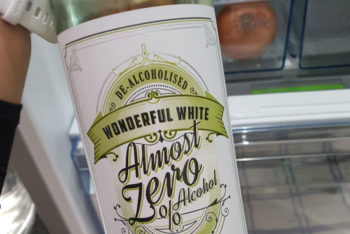St. Regis Chardonnay

St. Regis Chardonnay
Chardonnay / St. Regis NA / <0.5%
The golden yellow color reflects its light, aromatic, happy personality that evokes floral and fruity notes of exceptional depth and flavor including apricot and pear. On the palate, this Chardonnay offers a well-balanced, broad mouthfeel that leads into a medium finish.
There are a variety of reasons why one might seek out dealcoholized wines. Perhaps you are tired of suffering from the dread wine hangover. Or maybe you are simply trying to cut back on calories while still getting all of the health benefits that come from a glass of wine. Regardless of your personal reasons, it can no longer be said that your options are limited. There are plenty of dealcoholized wines out there on the market these days, including a wide range of varietals and varying degrees of quality.
Personally I have found that many of these vineyards are based out of California. Perhaps drinking dealcoholized wine is more popular in the United States. The first thing that stood out to me when I came across St. Regis is that the company is European. I can’t seem to find any information regarding the specific regions that the wine comes from, but their website claims that the grapes “come from some of Europe’s most sought-after vineyards.”
Like many wineries that are dedicated to creating delacoholized wine, St. Regis ferments and ages their varietals just like traditional wine and then remove the alcohol after the fact through the process of vacuum distillation. It seems that sometimes this alcohol removal process takes some other important ingredients along with it. But I have found that white wine retains its quality characteristics better than red. I’m hoping that continues to be the case here. Time to crack open a bottle and share what I find with this St. Regis Chardonnay review.
ST. REGIS CHARDONNAY REVIEW
Presentation is an important aspect of winemaking, perhaps more so than it realistically should be. St. Regis has a largely black and white label and aesthetic, but the front of the label is adorned with a geometric drawing of a bird, who is colored seemingly to match the shade of the wine in the bottle.
The golden color of the liquid is crisp and evokes thoughts of a bright summer day, sipping a few glasses in a garden setting. I tend to lean toward the attitude that white wine should be consumed primarily during the daytime, and red is better suited for after dark. So seeing a sharp golden hue such as this that I know won’t induce a nap makes me optimistic.
There isn’t much other information presented up front, but the back of the label tells us that a single 12-ounce serving of this wine contains just 60 calories, which is roughly one quarter of what a similar traditional wine would hold.
Upon taking in the aroma, I came across a familiar yet surprising scent. I recently sampled another dealcoholized Chardonnay and found this same thing. It’s a bit difficult to elucidate properly, but my best attempt is to call it a sweet mustiness. It’s not terribly appealing, and it is also underlied by a basic grape juice scent, which concerns me a bit. But the only way to truly evaluate any wine is by pouring it over your tongue. So let’s answer the question, “Is St. Regis Chardonnay good?”




Is St. Regis Chardonnay Good?
I am pleased to say that the flavor of this wine does not follow the nose. The musty scent disappears upon tasting, which does nothing to solve the mystery of where it comes from. The sweetness is still there, of course, and it is approaching too much for my personal tastes but stops short in a nice satisfying range.
There is a significant amount of fruit present. I find the strongest note to be green apple, but there is also a fair amount of pear and apricot. This results in a bit of sour tartness to balance out the sweetness. The levels on each of these components, while strong compared to what I expected from the nose, are completely reasonable and even each other out quite nicely. There are some more subtle floral dashes that are a bit overpowered by the sweetness but don’t really leave me wanting.
Another way that dealcoholized wine sometimes comes up short is in mouthfeel. This is where the watery sensation can come through and ruin the whole tasting experience. Not so here. The mouthfeel of this Chardonnay is quite full, with all of the fruit flavors dancing on your tongue. The finish falls somewhere between crisp and lingering. I would prefer it to be a little more sharp, but that comes down to personal taste. It is by no means offensive in the way it slowly fades from your taste buds.
Overall, I am happily surprised with the flavors in the mouth. The profile isn’t overly complex, but the combo of sweet and tart, which could easily come across too strongly, works very well. I could definitely see it pairing nicely with a fresh spring salad or even some seafood. But how will all of that play into my St. Regis Chardonnay rating? Finish reading to find out.
St. Regis Chardonnay Rating
I will come out and admit that Chardonnay is not typically one of my go-to wines, even when I am opting for a daytime white. I tend to lean toward the drier end of the spectrum but understand that, for many, the sweetness is the appeal. But after a bit of a rocky start on the nose, this dealcoholized Chardonnay from St. Regis won me over pretty strongly. To the point where I could actually see myself opting for it on a warm summer day or at least cycling it in and out with traditional wine to limit the alcoholic calories.
I won’t claim that it’s perfect, and the nose keeps it from earning a top grade from me. But I don’t believe that many people who enjoy a crisp white will be disappointed in this offering should they be looking for something a little healthier. If you are terribly opposed to sweetness, it could be a little much in that regard, but in my opinion, it finds a really nice balance. This is why I will end this St. Regis Chardonnay review by awarding it 4 out of 5 stars. Absolutely one of the better dealcoholized wines that I have sampled.




